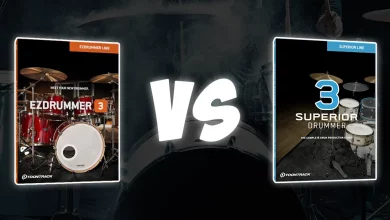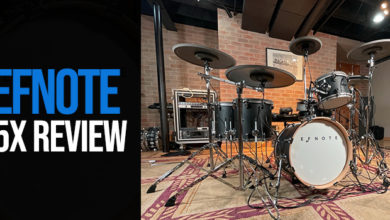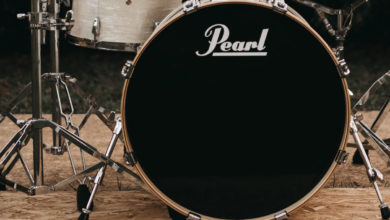
We may earn a commission from the affiliate links on this site. Learn more›
“What doesn’t kill us makes us stronger.”
Friedrich Nietzsche
Have a little look at the quote above. Yes, you’re still on DrummingReview.com. No, we’re not about to dive into the history of German philosophy (or offer an analysis of fancy mustaches)!
Nietzsche’s up there because—frankly—our Prussian pal’s famous maxim could’ve been harnessed by Pro-Mark’s marketing department.
[toc]It’s pretty much perfect for describing their Firegrain range of drum sticks. You see, these guys have been to hell and back. They’ve lept from the (figurative) frying pan into the (literal) fire and risen from the flames like a phoenix.

Promark Firegrain Drum Sticks
Extremely Durable Sticks
For drummers constantly breaking sticks and wasting money, look no further than Promark’s Firegrain sticks.
With these Firegrain sticks, Pro-Mark promises hickory that’s tougher than ever before – and twice as pretty.
Intrigued? Read on.
Context: The Drummer’s Curse
One of the more annoying things about being a drummer (or any musician, actually) is that most of the equipment we work with will break at some point.
Drum heads, cymbals, pedals, stands—any of one of these things can go. I was playing in front of a thousand people when my snare stand snapped, clean in half.
My snare drum went rolling across the stage like a hamster wheel, far out of my reach. I had to play the last two songs of a lively set, open-handed – hitting the floor tom with my right hand, in place of the recently-departed snare.
It was wild, and although I tried to make the best of a bad situation, it sure made me wish that someone had already invented indestructible gear!
Thankfully, this exact situation is rare. But there are more common breakages, and for most drummers, sticks will need replacing the most often.
No matter how refined our technique, our sticks are doomed from the moment we first use them; denting, chipping, peeling, and eventually snapping. And by the way: this is 99.9% guaranteed to happen during a gig!
The Search for an Antidote
With this very problem in mind, drum companies have experimented with a few alternatives to wooden sticks over the years, and there’s been mixed success along the way.
Around twenty years ago, carbon fiber sticks became popular for a while. These are typically jet black, and they’re usually far more durable than their wooden counterparts.
They’re lighter to hold—which some people like—but they typically feel harder against the skin, so they’re not always as comfortable to use for long periods.
The biggest problem with carbon fiber is that it doesn’t sound like a wooden stick. Cymbals tend to sound tinnier under this material, and drums sound a little cold too.
For these reasons—and maybe some others—carbon fiber sticks never really took off. (Manufacturers still release new versions of these drumsticks now and then, so perhaps the technology will improve over time.)
There is another alternative to wooden drumsticks, which stands above the rest, and it was developed by Ahead – a brand that initially specialized in crafting non-wooden baseball bats and hockey sticks.
Their offerings are of consistently high quality but tend to be sold at nearly twice the price of a good quality wooden stick. So this is the world that Pro-Mark’s Firegrain sticks have been born into.
Let’s see how they stack up!
Playing With Fire
Pro-Mark’s Firegrain sticks have been around for a few years now. There’s a wide range of sizes available: the 7A, 5A, 5B, and 2B variants come with an oval tip, and the 5A and 5B versions are also available with an acorn tip.
They’re reminiscent of Pro-Mark’s Millenium II range, both in terms of their size and shape and the fact that both ranges are made from hickory.
Unlike the Millenium II’s, all Firegrain sticks are heated to four thousand degrees before coming off the production line. (If that’s not the definition of ‘playing with fire,’ I don’t know what is!)
This same heating process is often used in building construction. It binds the fibers in a piece of wood to be tightly interwoven, and therefore harder to break.
All of this sounds pretty good! But does it work?
The Visuals
For starters, before you even hit a single drum with a Firegrain stick, you’ll notice how stunning they look.
They’re all golden-brown, burnt orange, and black.
The grain of the wood looks high-end, and the whole stick has a faintly glossy sheen. On the shaft of the stick, you’ll find the typical Pro-Mark branding written in golden letters, and a nifty little golden flame sits further up the stick (which, incidentally, would make a pretty nice tattoo)!
Apart from the fantastic visuals, these sticks even smell nicer than any I’ve used before! Immediately upon opening, you’re hit by the smokey, barbecue scent of flame-grilled wood, which—in my experience—lingers on the stick for several weeks.
Sure, it makes me a little hungry for steak, but it also reminds me of Summer—so for me, it’s a nice bonus!
The Feel
I usually use 5B sticks, and these Firegrains feel a shade heavier than standard hickory to me, but this might be a weird illusion. Technically, there should be no weight difference at all.
I’ve always loved the Millenium II range because they feel super comfortable in hand. Firegrains feel a little stiff by comparison, and—apparently—this is an unavoidable effect of the wood-burning process.
That said, they’re not horrible to hold. To me, they feel a little like Vic Firth’s American Classic range. So sure, I had to develop an extra callous or two on my fingers, but that was no big deal in the end.
They’re a little front-heavy, and I found that this quality makes them conducive to playing an easy Moeller stroke. They also bounce nicely, so utilizing the drop/catch technique – and similar – is easy enough. It’s also nice and easy to bounce them off the floor if, like me, you find that kind of thing entertaining!
The Sound
Encouragingly—and unlike the carbon as mentioned earlier fiber sticks—these sound very much like standard, hickory drumsticks.
Because they’re a bit harder than some drumsticks, they sound a little heavier on my cymbals, which took some getting used to.
They seem to bring a slightly ‘toppy’ tone out of everything they touch. In truth, this is pretty subtle, but it’s still there.
I got used to the change of tone after about a week, and if any bandmate or sound guy has ever noticed the slightly toppy sound, they’ve never said so.
This change hasn’t caused me any significant problems. I wouldn’t see it as a barrier unless you’re attached to your drums’ particular tone in their current form.
Durability
Aside from the striking visuals, the most noticeable difference between the Firegrain and Pro-Mark’s other sticks is the durability factor, and this is—very arguably—the point of buying them in the first place.
I can’t offer a carefully regulated, scientific study to prove that the Firegrain range is highly durable, but I can share my own experience.
I’m a relatively hard hitter, and I play a lot of rock music.
I play live, in the studio, at rehearsals, and in my practice time. I bought two pairs of Pro-Mark Firegrain 5B’s in 2017.
In that time, not one stick has broken. Not a single stick.
One feels like it’s on the way out now, and I’d only use it in an emergency, but the others are still going strong.
Although these sorts of results will vary from drummer to drummer and depend on a myriad of variables, I can confidently say that this fire strengthening thing seems to work pretty well!
The Verdict
We’re musicians. Our equipment will break, and over time, the expenses will rack up. It’s a fact of life, and sometimes it can be pretty hard to swallow.
Even in the advanced days of 2021—in an age when tech moguls like Elon Musk are setting their sights upon Mars—a guitarist’s strings still snap, a violinist will shred hair from their bow, and a saxophonist will split reeds.
Drummers have this problem in spades because we play our instrument by hitting it. Any company trying to make more durable drums, heads, cymbals, or sticks will run into some problems. If you start playing around with materials to make them more durable, you inescapably alter the tone that the material creates—and this doesn’t always lead to great results.
So there’s a delicate balancing act for any manufacturer that wants to explore this trade-off between tone and toughness.
In Pro-Mark’s Firegrain range, I’d say that we have a pretty good balance between these separate considerations.
These sticks are super-tough, and although they will change the tone of your drums and cymbals a little, it’s not a particularly dramatic or unpleasant change.
Consider the fact that they also look beautiful and smell vaguely like barbecues, and you’ve got yourself a few good reasons to pick up a pair!
My advice? If you’re after a rigid stick that feels natural in hand and sounds like the real wood it’s made from, you could do a lot worse than these.
In short, this is a drumstick that Friedrich Nietzsche would’ve been proud of!

About the Author
Chris Witherall is a pro drummer, producer and songwriter from London, England. He loves talking about music, and helping people to reach their music goals.




I recently tried the 2B Firegrain sticks exclusively for 2 weeks and found I can’t go back to anything else and feel this comfortable. I changed the tuning on my drums for the extra tone the sticks bring out and love them. 2B or not 2B ? Firegrain 2B for me!
0